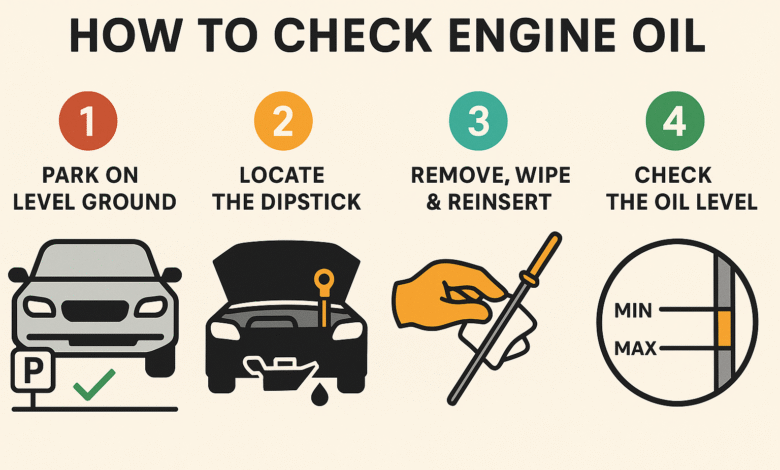Way to Check Engine Oil Level: A Simple Guide
Learn the correct way to check your engine oil and ensure your car runs smoothly and efficiently.

How to Check Engine Oil: A Complete Guide to Keeping Your Engine Healthy
Engine oil is the lifeblood of your car’s engine. It lubricates the moving parts, reduces friction, removes heat, and prevents wear. Knowing how to check engine oil properly is a vital skill for any vehicle owner. This guide will walk you through everything you need to know, using clear steps and helpful insights to ensure your engine stays in top condition.
Why Checking Engine Oil Matters
Regularly checking the engine oil level helps you:
-
Avoid engine damage
-
Know when it’s time for an oil change
-
Ensure your car’s engine runs smoothly
-
Detect problems early (like leaks or burning oil)
A simple oil check could save you thousands in repairs. It only takes a few minutes and can prevent major mechanical failures.
When to Check Engine Oil
Best Time to Check
For an accurate reading, the best time to check is when the engine is cold or has been off for at least 10 minutes. This allows the oil to drain back into the oil pan for a proper measurement.
-
First thing in the morning (stone cold engine) is ideal
-
Always park your car on level ground
-
Avoid checking right after driving; hot oil may give a false reading
Tools You’ll Need
-
Clean cloth or paper towel
-
Access to the owner’s manual
-
Possibly a quart of oil if a top-up is needed
Step-by-Step Guide: How to Check Engine Oil
Step 1 – Park on Level Ground
Before anything else, ensure your vehicle is on a level surface. This is key for getting an accurate reading.
Step 2 – Let Engine Cool Down
Turn off your engine and wait at least 10 minutes so that oil has drained into the bottom of the engine.
Step 3 – Locate the Dipstick
Pop your hood and locate the oil dipstick. It usually has a brightly coloured handle (often yellow or orange).
-
If unsure, consult the owner’s manual
Step 4 – Remove the Dipstick
Pull the dipstick out and wipe it clean with a cloth or towel. Make sure to clean both sides of the end of the dipstick.
Step 5 – Reinsert and Remove Again
Reinsert the dipstick fully and wait a second. Then pull it out again to read the dipstick.
Understanding the Dipstick Reading
Oil Level
Look at the oil level reading:
-
Between minimum and maximum oil levels: you’re good
-
Below minimum: you need to add oil
-
Above maximum: you may have an overfill problem
Many dipsticks use hash marks or a crosshatched area to show the safe zone.
Oil Colour and Consistency
Fresh oil is usually amber. If it looks dark or dirty, it may be time to change the oil.
If you see foamy, milky, or gritty oil, this could indicate:
-
Water contamination
-
Engine wear
-
Time for an urgent oil change
How to Add Engine Oil If It’s Low
-
Find the oil filler cap (often marked “engine oil”)
-
Use a funnel and pour slowly
-
Start with half a quart of oil, then re-check the oil level
-
Repeat until oil reaches the correct level
-
Don’t exceed the top line — overfilling can damage the engine
You can use full synthetic, synthetic blend, or conventional motor oil, depending on what’s recommended by the manufacturer.
Tips for Accurate Oil Checks
-
Always check both sides of the dipstick
-
Make sure the car is on a level surface
-
Don’t confuse electronic oil gauges with manual checks—some cars use both
-
Clean the dipstick thoroughly each time
-
Refer to the owner’s manual for the correct type of oil and oil viscosity (e.g. 5w-30)
Common Questions and Misconceptions
Hot or Cold – What’s Better?
While some manuals say you can check oil with a warm engine, the most consistent results come when the engine is cold, especially first thing in the morning.
How Often Should You Check?
Experts recommend checking the oil level:
-
Once a week for older cars
-
Every two weeks or once a month for newer cars
-
Before long trips
Warning Signs You Need to Check Your Oil
-
Oil warning light on your dashboard
-
Strange engine noises
-
Decreased performance
-
Smoke from the exhaust
-
Burnt oil smell
If you notice any of these, it’s time to check your oil level manually.
Additional Maintenance Tips
-
Replace oil filter during each oil change
-
Never ignore low oil warnings
-
Change the oil every 3,000 to 7,500 miles depending on your vehicle and oil type
-
Use conventional oil or synthetic oil as recommended
Frequently Asked Questions (FAQ)
Q1: How do I know if my engine oil is low?
Check the oil level using the dipstick. If the oil mark is below the minimum line, you need to add oil.
Q2: Can I drive with low engine oil?
It’s strongly discouraged. Driving with low oil can lead to engine overheating and permanent damage.
Q3: What happens if I overfill the oil?
Too much oil can cause pressure buildup, oil foaming, and engine seal damage. Drain the excess or have it checked.
Q4: What type of oil should I use?
Check your owner’s manual. Most modern engines use 5w-30 or synthetic oil, but it varies by make and model.
Q5: How long should I wait after turning off the engine to check the oil?
Wait 5 to 10 minutes for the oil to drain to the bottom of the engine before pulling the dipstick.
Conclusion
Knowing how to check engine oil is one of the easiest and most important ways to keep your vehicle in good shape. By regularly checking and maintaining your engine oil level, you’ll extend your engine’s life, prevent costly repairs, and drive with peace of mind.
Take control of your car care today by making oil checks part of your weekly routine. Remember: a little prevention now saves a lot of trouble later.



